Time Reconsidered: Why The Minerva Pythagore Is The Great Horological Litmus Test
Long before “vintage-inspired” became a trend, the Minerva Pythagore quietly forecast the future of watch collecting — from the golden ratio to an early watch forum legend.
The first time I heard of Minerva was when my wife gave me an engagement watch, a Montblanc Heritage GMT with a salmon dial. I’ll spare you the sentimental details (though I will say this: always push for an engagement or wedding watch… wink, wink). What caught my attention was the caseback, engraved with an image of the Minerva factory in Villeret, Switzerland, better known today as the Institut Minerva de Recherche en Haute Horlogerie.

That building has been a quiet witness to over 160 years of uninterrupted movement manufacturing and was acquired by Montblanc in 2007.
At the time, I didn’t think much of the engraving. But as my curiosity deepened, I realized that Minerva wasn’t just another footnote in Montblanc’s branding. It was a name with real historical weight and one that often gets glossed over despite its significance in the world of movement making.
I assumed Minerva was just a movement manufacturer of the past, but soon it came full circle after an interview with Logan Baker, who cited a Minerva Pythagore as one of the favorite pieces in his collection. From there, the thread unraveled, as it so often does.
What I found is that the story of the Pythagore, and its place in the hearts and minds of collectors, is anything but straightforward.
To call it “controversial” feels a bit too tabloid, too sticky. But there’s definitely something about the Pythagore that stirs the pot. The three handed, time only, Calatrava-esq watch drummed up some serious hot takes back in the old-school TimeZone forums and beyond. It drew hard lines in the sand when it came to taste, value, and what matters in watch collecting. In fact, your take on the Pythagore might be the best litmus test I’ve found, an almost uncanny barometer for someone’s horological worldview. It is kind of how I feel about people’s music tastes if they can’t tell me one Stevie Ray Vaughan song.
But before we get there, let’s rewind the clock (forgive me for ever saying that), to the beginning of the Minerva story, because only with that context can you fully understand why this watch became the cult classic (in my opinion anyway) that it is today.
History of Minerva

Minerva traces its origins to 1858, when it was established in Villeret by the brothers Charles and Hyppolite Robert. The name Minerva comes about as the Robert Family began trademarking different brands under their umbrella company now called Robert Frères Villeret, starting with “Mercure”, eventually adding “Minerva” (the goddess of farming, craftsmanship and science) in 1887.
For decades, the brand carved out a niche as a solid mid-tier manufacturer, producing reliable timepieces with broad appeal. By 1908, Robert Frères had shifted its focus to precision timing with the development of its first chronograph movement, the caliber 19-9. Like many of the chronographs that would follow under the Minerva name, it featured only a minute counter.

As Minerva became the hallmark for the company’s top-tier offerings, its reputation for high-precision chronometry spread. By 1916, the brand had developed mechanical stopwatches capable of timing to 1/100th of a second. That level of accuracy made Minerva a go-to name in competitive timing, specifically in the evolution of motorsports.
Skipping forward to The Great Depression, as with many companies, the financial struggles forced a change in ownership, and the company was eventually acquired by Jacques Pelot, a longtime employee. In 1940, Pelot brought his nephew, André Frey, into the fold, beginning what would become a three-generation family-led operation.
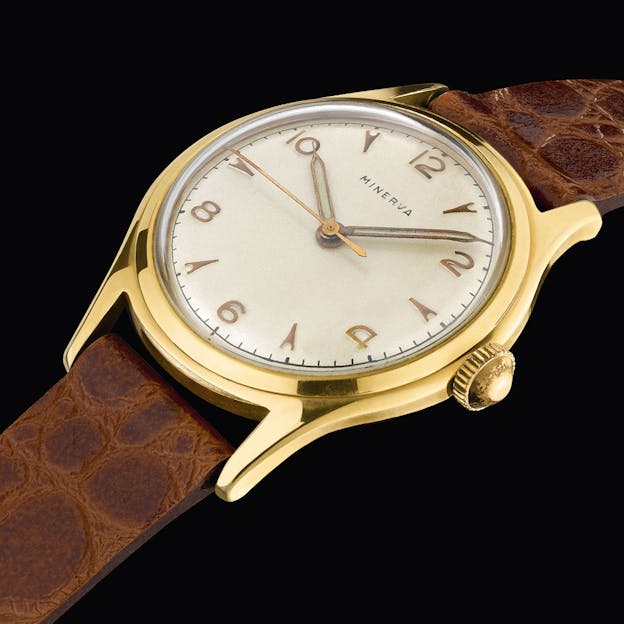
In 1943, André Frey, created a movement that would quietly become one of Minerva’s most distinctive achievements, the caliber 10-48. What set it apart wasn’t just the mechanics, but the philosophy behind its design. Frey laid out the bridges according to the Golden Ratio (1.618…), a mathematical proportion found everywhere from seashells to cathedrals. It’s a ratio often attributed to Pythagoras. So when it came time to name the watch housing this movement, Pythagore just made sense.
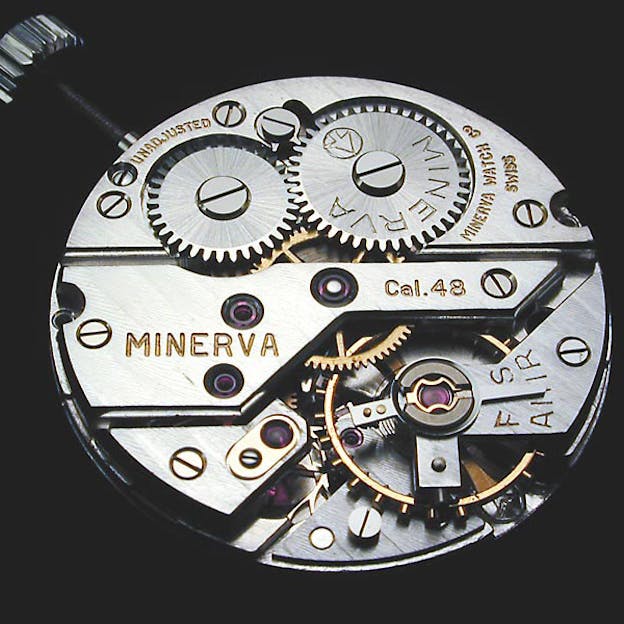
When this movement was first produced, no one could admire it. The famed movement remained hidden behind a closed caseback. But to understand its significance, it’s worth turning to Jean-Jacques Frey, son of André, who said in a 1998 interview with TimeZone’s Richard Paige, “I believe the motivations behind any creation make the sense of things, their virtue. In that respect, the Pythagore watch with its movement 48 offers truly a cultural object, although minor of course, and these pieces of our environment with this cultural touch, with a virtue, are more and more precious in our modern world.”
In other words, its beauty wasn’t just in how it looked, it’s what it stood for.

The story of Minerva is important context because Minerva was a vertically integrated manufacture that never aimed for large-scale production. Instead, it remained a highly selective ébauche supplier throughout its history. Remarkably, Minerva has maintained continuous production of mechanical movements in the same building from 1902 to the present. That kind of continuity is rare, and all the more impressive when you consider that the number of Swiss watch companies dropped from 1,618 in 1970 to just 632 by 1984. Minerva held firm through it all.
Panerai used modified Minerva chronograph movements in a few very limited early post-Vendôme prototypes or special editions for over 50 years. One notable Panerai with some level of certainty that used a Minerva movement is the PAM 322.
There are persistent rumors (though not definitively confirmed by archival records) that Minerva supplied or influenced movements for Zenith chronographs in the mid-20th century, though these may have been in the form of component-level collaborations or shared suppliers rather than full movements.
By the time Minerva sold to an Italian holding group in late 2000 they employed six full time employees and produced roughly 1,000 wristwatches a year. This number excludes their stopwatch production. They were never highly marketed and due to this took on a bit of a mythological status. Minerva’s allure was built on a kind of romantic illusion that a small, independent workshop could quietly craft refined, in-house mechanical watches at prices within reach.
To those who bought into that dream, Minerva became a symbol, a tool to challenge the bloated pricing, outsourced calibers, and overhyped marketing that plague much of modern watchmaking.
The Pythagore 2000
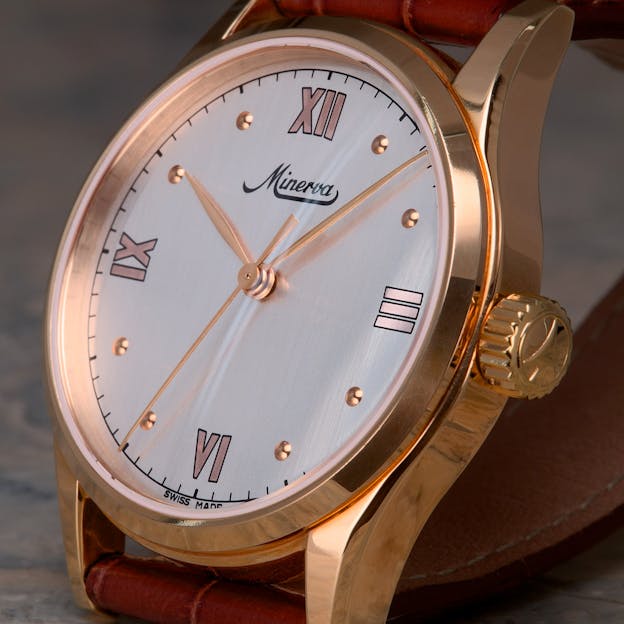
The Minerva 2000 made its debut in the summer of, well, 2000, marking the return of the long-dormant caliber 49 to the catalog. Essentially a variation of the famed caliber 48, this version featured a center seconds hand rather than the traditional small seconds. Fewer than 200 pieces were reportedly produced.
The case of the 2000 mirrors that of the original Pythagore from 1943, at 34mm but with a slightly thicker profile of 8.9mm versus 8.5mm, to make room for the additional gearing needed for the center seconds. Every example of the 2000 came with a swan’s-neck regulator, something that was merely optional on earlier Pythagore models. And then there’s the 18k gold case that sits somewhere between yellow, rose and pink gold. It was a stunning vintage recreation that hit every note a true watch collector could ask for.
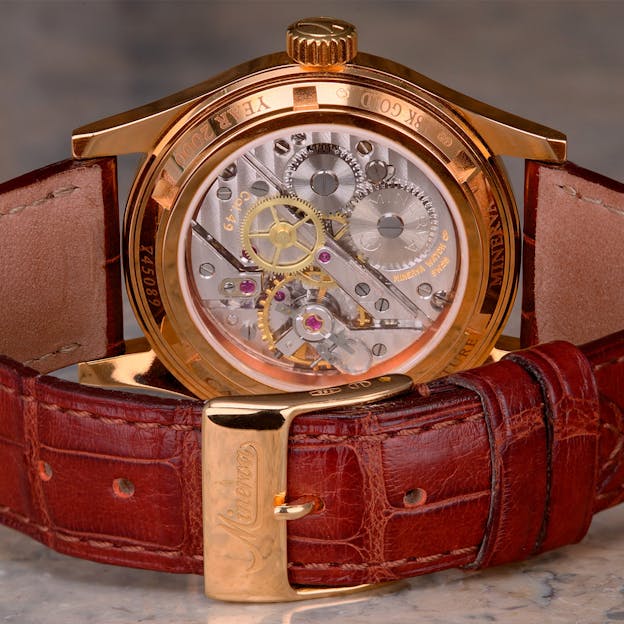
The movement was most undoubtedly finished by hand, yet it would be hard to compare this to some of the hand finishing we see today from top-tier luxury brands. And this is where you generally find the divide among collectors. Minerva’s reputation as the scrappy underdog was, to some, more internet folklore than fact. Critics pointed to flaws in the construction and finishing of the modern caliber 48 and 49, seeing them as evidence of corner-cutting, a blemish on the brand’s legacy. After all, watchmaking is nothing if not a world obsessed with details. But then again, what’s a good story without a little controversy?
But when you consider the original price tag of roughly $3,200 it represented an incredible value and appealed to any vintage watch lover. It is what you would expect to find shopping for a dress watch in the 50’s but for the modern age.
There were whispers of a stainless steel version to follow, but that never materialized. Instead, the 2000 stands as the final full-production watch released under the Frey family’s independent stewardship.
The TimeZone Limited Edition Pythagores
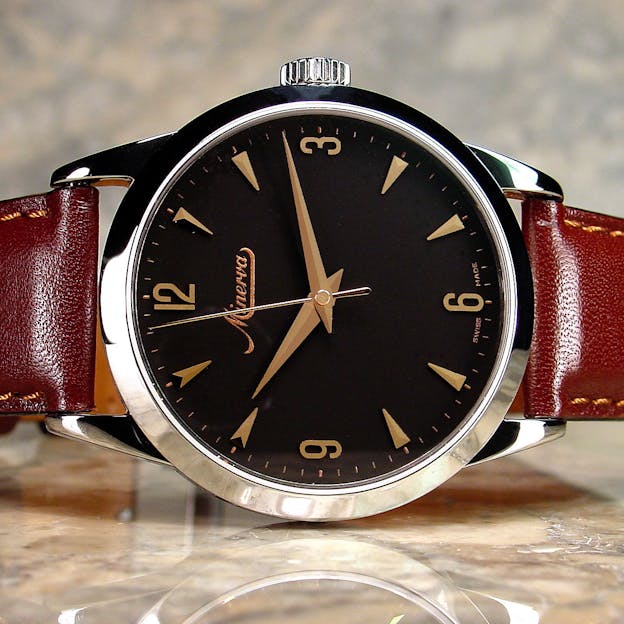
An additional anecdote to the story of the Pythagore lives in the back pages of the watch internet with the TimeZone LE, which was slightly larger at 36mm and in a stainless steel case. The TimeZone Limited Edition (TZLE) was the result of a collaboration between Richard Paige, founder of TimeZone, and Jean-Jacques Frey of Minerva. You can still dig through the archives at TimeZone for the full backstory, but the essence is this: a watch designed by someone who truly loved Minerva, brought to life by a manufacturer who genuinely valued the watch community.
“The Freys were very early into that game of engaging directly with the community.” Former TimeZone Manager and VP of Watch Merchandising for The 1916 Company Michael Sandler said. “And because the size of the company wasn’t huge, it was manageable. So, that brand became a bit of a darling for TZ. It was this perfect little experiment to do with this sort of limited edition, at an accessible price point.”
There were two runs of the TZLE, one run of the caliber 48 Pythagores in 1998 with a black dial and the TZ logo front and center, and another in 1999 using the caliber 49. The second run had two variants, a black and white dial, with only 49 made of each. A nod to the caliber 49. Each watch was priced around $1,300.
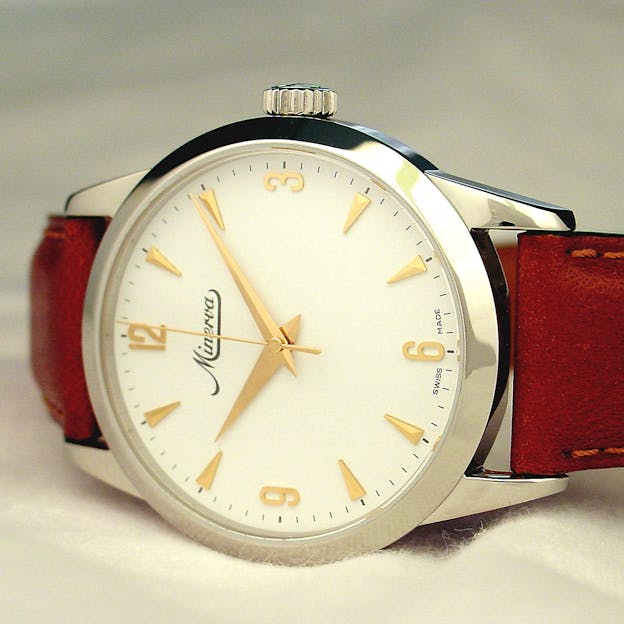
The cases were crafted using original vintage tooling, paired with a period-correct dial and design cues. Inside, the movement received what many consider the most refined finishing ever applied by Minerva, arguably (according to the old-school collectors and followers of the forum) the brand’s crowning achievement.
But just as the project launched, Minerva was sold, and not long after, Jean-Jacques Frey stepped away from daily operations. What had felt like the culmination of a remarkable comeback for this tiny, resilient manufacture instead became its closing chapter under the Frey family’s stewardship.
TimeZone holds a special place in the hearts of many in the watch world. It’s where people like our own Jack Forster first made their mark, and where figures like Ben Clymer, Ariel Adams, and William Massena launched their careers. Back then, it wasn’t just a forum, it was the pulse of the collecting community. The Frey’s knew this and actively engaged with their community when many brands in the industry did not.
Why This Watch Matters
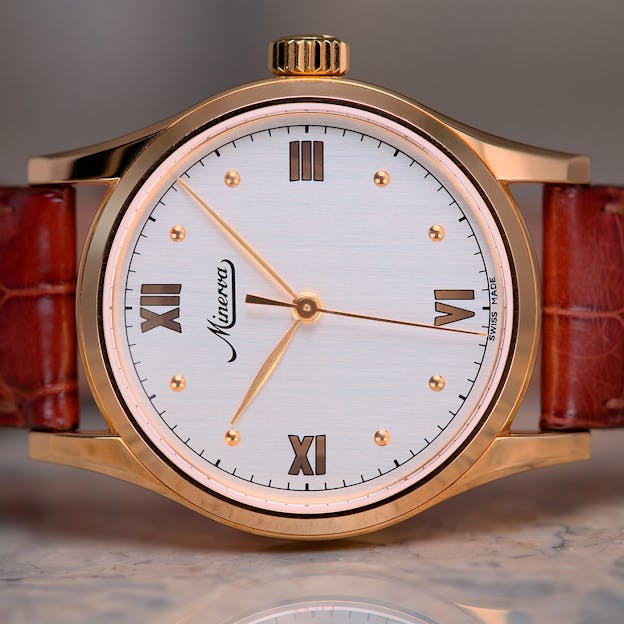
Minerva is a name that tends to live in the shadows, known mostly by the initiated, and now a footnote under Montblanc within the Richemont machine. But the Pythagore, and specifically the Pythagore 2000, represents a quiet turning point in modern watch collecting. This was one of the first moments when the industry truly started listening to collector sentiment and when brands really began dusting off their archives and reimagining heritage designs for a new era.
The run of Pythagores from the 1998 TZLE to the 2000 marks what I’d call the beginning of the “vintage revival” era, which is a trend we still see everywhere today, arguably to the point of exhaustion. One that was birthed on the internet and marks a significant turning point in our grand horological timeline. Yes, there were plenty of other Pythagore’s which were produced between 1943 and 2000, but those last few years, were something special.
Some may argue the return of the Reverso in in 1975 thanks to Mr. Corvo, or even the 60th anniversary editions in 1991 were the start of the vintage revival. Others could even point to the IWC Mark 12 in 1994 as the beginning. Some may think it’s a stupid argument or conversation to even have as all originality is dead, but I am not a nihilist, nor does it feel like those “re-editions” quite highlight what this watch means to the watch collecting world as an inflection point. The brief return of the Pythagore from 1998-2000 is what the kids call today a deep cut.
Minerva may live on today, stamped inside Montblanc cases, but its long history of being a bit of the black sheep, is what makes it so compelling to me. The Pythagore isn’t just rare by production numbers; it’s meaningful. It’s history wrapped in restraint, design rooted in geometry, and a movement that speaks fluently in the language of real watchmaking.
To be honest, I’ve grown tired of the endless stream of brands raiding their back catalogs, chasing ghosts of former glory and almost always missing the point. But the Pythagore? This one gets it right. This is my litmus test. If you love this watch, you probably get what makes watchmaking worth caring about in the first place. It doesn’t scream. It doesn’t posture. It simply honors the past and carries it forward, the way it should be.
A special thanks to Steve Gurevitz for the photos. You can find more of his watch coverage at his watch launchpad here.

